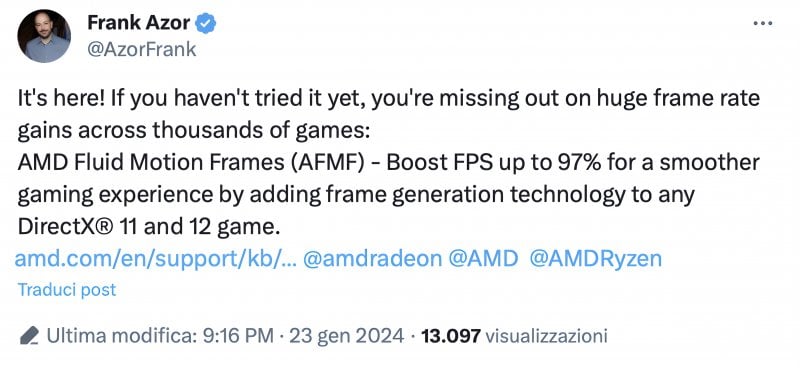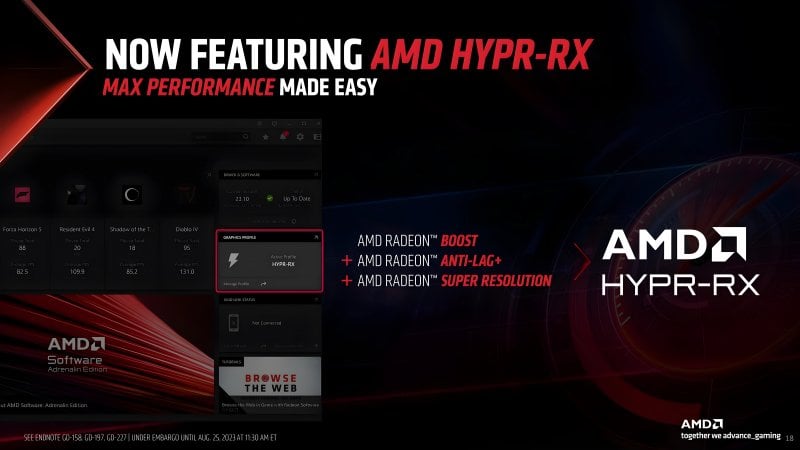The new AMD technology that “brings” frame generation to thousands of titles is finally available.
And the day finally came!
As we had already announced a few days ago, today AMD has finally made the latest official drivers available which not only bring support to the new RX 7600 XT but also mark the official release of a very interesting technology from the preview channel, Fluid Motion Frame Technology (AFMF).
This new technology appeared for the first time in September in the preview drivers of Radeon video cards and is based on a frame generation concept similar to the other two technologies already known to the general public, NVIDIA's DLSS and AMD's FSR, albeit with one big and important difference.
Let's briefly review together why this technology, despite not being able to offer the same graphic performance as other upscaling systems, is extremely important and worthy of attention.
Frame Generation for thousands of titles
If the scope of this technology is not yet clear, we invite you to evaluate the enormous potential of being able to apply a feature like Frame Generation to any DX11 or DX12 game without the slightest involvement from the game developers.
Until now, applying DLSS or FSR required an effort from the software house teamwhich should have been responsible for implementing one or the other system (or both, as we have already had the opportunity to write) and therefore making this important advantage available to users.
However, a quick look is enough to compare the range of titles released since the birth of Frame Generation technologies and the actual number of games where these technologies are implemented to realize a glaring truth: Technologies win when they are exploited massively and can potentially end up in the hands of anyonewith minimal effort perhaps.
The most innovative of the poorly implemented technologies will remain the prerogative of super enthusiasts and without finding an outlet in the market of normal users it will not find a way to establish itself, if not with enormous efforts and even more enormous investments.
Of course, both AMD and NVIDIA have made enormous efforts to develop this type of technology and it is even more obvious that they are committed to working closely with the most important dev teams, but this does not solve the basic problem: the adoption rate.
Interconnected technologies
AMD declares in the driver changelog that thanks to this technology, to be used in conjunction with others from the Hypr-RX suite, truly “monstrous” performance increases can be achieved in terms of FPS: +97% means without half measures doubling the FPS with a click of the mouse.
See, although they will then have to be confirmed by real field testsincreases of this type and to think that they were obtained “solely” via drivers is truly something that can leave one speechless, but in any case we repeat what we have already written: “Frame generation technologies are not miracle solutions capable of completely changing the performance of a game.”
What appears truly praiseworthy and worthy of all praise for AMD is the adoption rate with which this technology is presented to the market: in fact, all you need is a VGA Radeon RX 7000 (RDNA 3) or RX 6000 (RDNA 2) or – for the handheld world – a Radeon 700M (RDNA 3) to enjoy AFMF.
To all FPS!
Precisely this implementation in the handheld world we have already had the opportunity to say what implications it could bring, not so much on brute power in terms of FPS but on the potential saving of resources while guaranteeing the right usability.
In any case, we must keep our feet on the ground: if up to now we have talked about all the positive aspects of this technology and the extreme positivity of being able to adopt it without particular efforts only by having a recent Radeon video card, it is necessary to keep in mind that an implementation of this type it does not allow you to achieve the results of DLSS or FSR and may not always offer the desired results.
We will certainly have the opportunity to try AFMF technology extensively now that it has been made public for everyone and no longer just in the preview channel, where it is reasonable to expect some malfunction and/or problem, especially in the initial phase.
In the meantime, we can only congratulate AMD for this very welcome addition to their technology portfolio!
#AMD #Fluid #Motion #Frame #Technology #finally #Here39s


